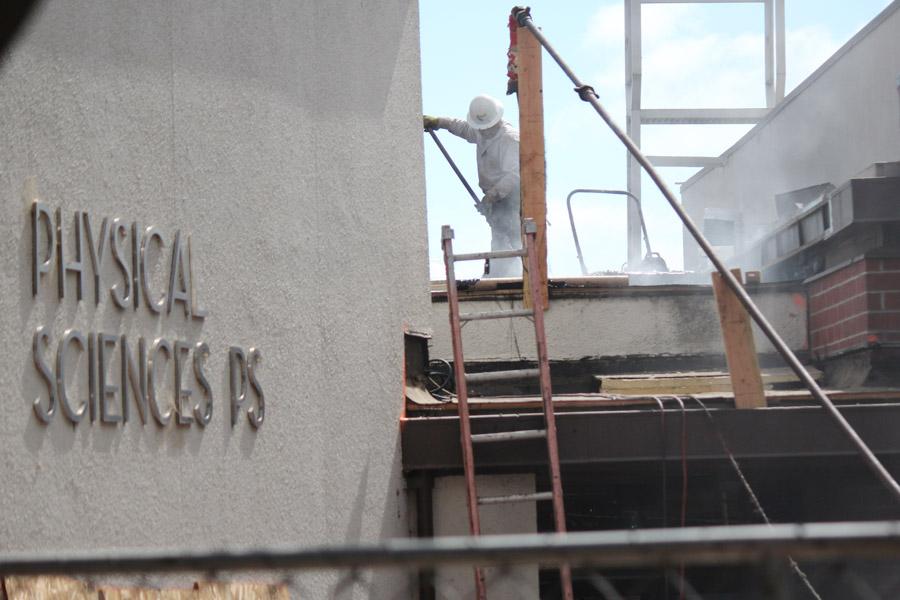Seismic retrofitting upgrades buildings
‘Seismic risk levels,” drives college toward improvements to old structures on Hayward Fault
Christian Urrutia / The Advocatae
A construction worker tars the roof of the Physical Science Building on Aug. 20. The 58-year-old building recently received seismic retrofits between the summer and fall semesters to reduce risk of injury to occupants in the event of a major earthquake.
Sep 9, 2014
Since the campus rests atop an active fault line, two of the oldest classroom buildings were seismically retrofitted between the summer and fall semesters.
The nearly 60-year-old Biological and Physical Science buildings, as well as the Football Press Box and maintenance warehouse, received necessary retrofits in the five-week gap because of their proximity to the Hayward Fault, an active earthquake fault running through campus that geologists consider past due for a major earthquake.
Today, amid classes and the bustle of students, construction workers continue to polish off the minor details of their punch list in the BS and PS buildings before the project can officially be completed and contracts signed.
“It was a full-time job; we were on-site every day, all day,” John Leary, construction project manager for Critical Solutions, Inc., said. “We knew butts had to be in seats by Aug. 15, no exceptions.”
Contracted by Critical Solutions, Inc., SW Allen Construction, Inc. out of Sacramento secured the bid for the retrofit project at $975,000, less than the $1.6 million soft cost estimate made by officials from Thornton Tomasetti Building Solutions, Inc. Funding for the project comes from a 2006 California State Bond measure rebate of about $8 million.
Leary said that despite the tight time frame, the renovations were completed on time and went smoothly, with the exception of a clipped electrical wire that has left the BS Building without functioning clocks.
Kinesiology major Valeah Downer said that she has noticed a construction crew fixing the roof of the PS Building, a separate project of the college’s, but was unaware of the retrofits administered to both buildings over summer.
Because she takes classes in the 54-year-old BS Building, Downer said she hopes the retrofits serve their intended purpose in event of a major earthquake.
The Contra Costa College Seismic Evaluation and Retrofit Studies report prepared by Thornton Tomasetti in November 2010 details the extent of structural and non-structural deficiencies of all buildings on campus. Each building was assigned a seismic risk level between I and VII, with level VII posing the greatest risk to occupant safety in event of a major earthquake.
The BS and PS buildings were at seismic risk levels IV and V, respectively, prior to receiving retrofits.
“If you’re a student, you wouldn’t think we did anything,” Leary said. “Most of the retrofits are pretty much invisible.”
He said that structural steel braces and connections were added to the BS Building, as well as X bracing to exterior walls. Near the center of the building, part of the floor was excavated to replace existing concrete and rebar to stiffen up that section, where two new shear walls have been erected.
In five classrooms and the hallway, compression struts were added to strengthen the grid ceiling, designed to keep panels from popping up during a temblor and falling down, he said.
The PS Building received compression struts in the hallway and in offices 107-109. Braces have been placed where the roof and exterior walls connect to reinforce the outside edge of the building, he said.
Buildings on campus that have been retrofitted include the Early Learning, Computer Technology, Library and Learning Resource and Student Services centers and the Liberal Arts Building.
“Having been in California so long, earthquakes seem iffy since I’ve experienced many. Maybe it’s because I was born after the big one (Loma Prieta, 1989) and didn’t experience the damage, but generally I’m not too worried,” Evelyn Leon, electrical engineering and computer science major, said.
“But I think it’s wonderful they did (the retrofitting) and fixed the old buildings right up.”


